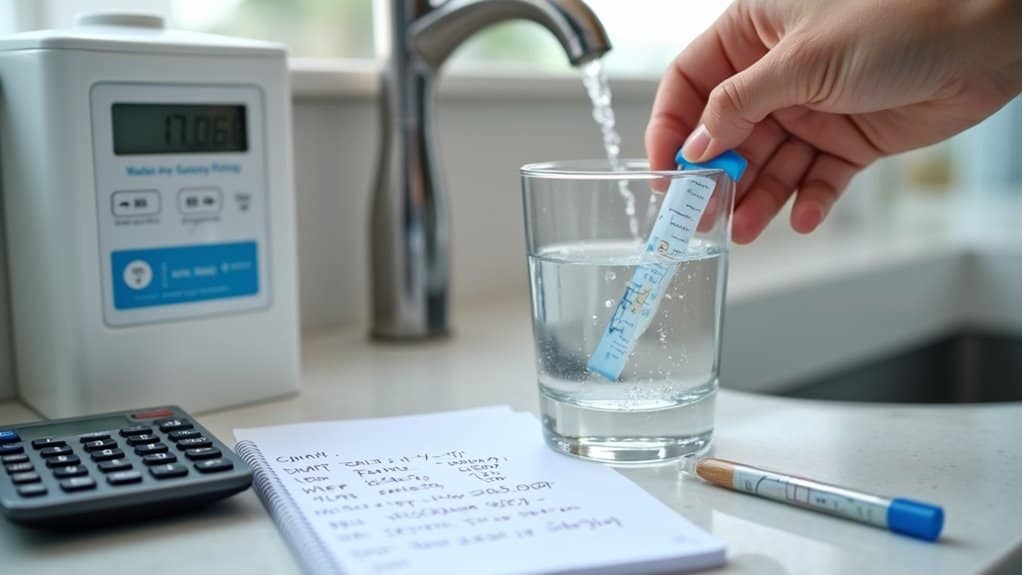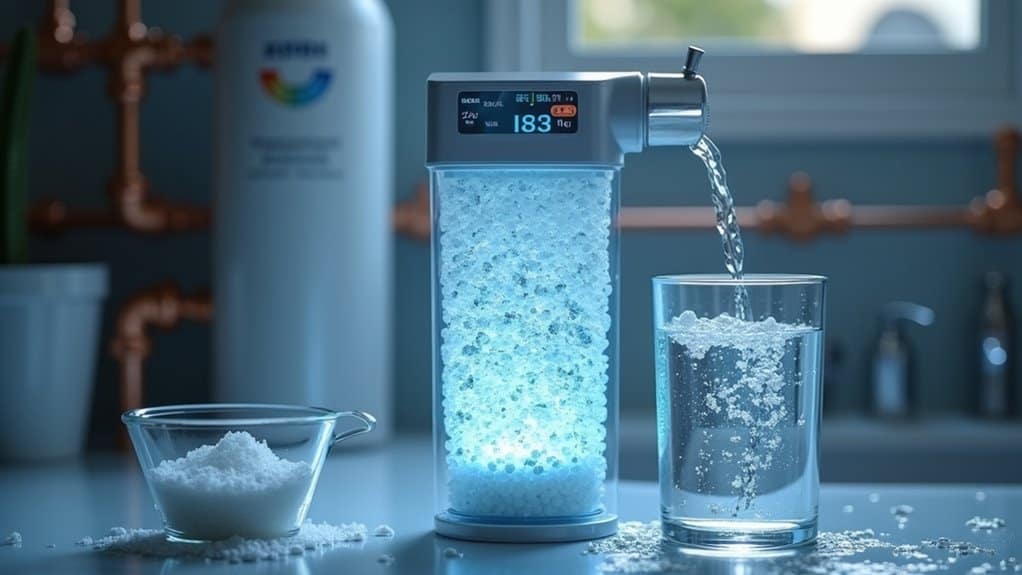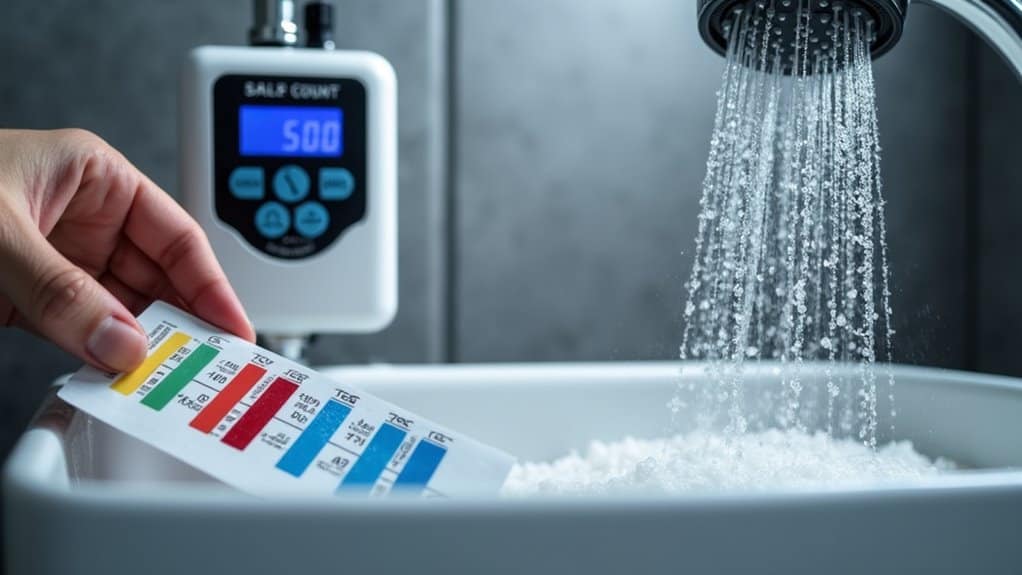To never run out of soft water, use this formula: daily water usage (gallons) × water hardness (GPG) × days between regenerations. For a family of four, calculate 75 gallons per person × your water hardness × 7 days. Add 4 GPG for every 1 ppm of iron present. We recommend upsizing by 10-20% for unexpected usage spikes and selecting a demand-initiated regeneration system. Our detailed sizing guide below will transform your water softening experience.
Key Takeaways
- Calculate your system’s grain capacity by multiplying daily water usage × water hardness × days between regenerations.
- Size your softener at least 20% above calculated needs to account for usage spikes and resin efficiency loss.
- Add 4 grains for every 1 ppm of iron in your water when calculating total hardness.
- Choose demand-initiated regeneration systems to prevent running out during high-usage periods.
- Match resin volume to required capacity: 1 cubic foot handles approximately 20,000 grains.
Understanding Water Hardness: The Foundation of Your Calculation

Before calculating your softener’s capacity, we must establish a clear understanding of water hardness measurements.
Water hardness is primarily measured in grains per gallon (GPG), with 1 GPG equaling approximately 17.1 parts per million (ppm) or milligrams per liter (mg/L). Hardness test results alone can be misleading, as hardness tests do not account for other critical factors influencing softener sizing.
Water classifications range from soft (<3.5 GPG) to moderately hard (3.6-7 GPG) to hard (7.1-17.5 GPG).
For accurate calculations, you’ll need to determine your specific hardness level, typically through testing.
When reviewing test results, note that calcium hardness is calculated as mg/L × 0.4.
International measurements like German degrees (dH) aren’t commonly used in American systems.
You can perform a simple at-home test by filling a bottle with tap water, adding liquid soap, and observing bubble formation after shaking.
The Simple Formula for Determining Your Exact Grain Requirements

Now that we’ve established how water hardness is measured, let’s focus on calculating your exact softening requirements.
The core formula is straightforward: multiply your daily water usage (in gallons) by your water hardness (in grains per gallon), then multiply by 7 for weekly regeneration. This approach ensures you have a water softener that meets your home’s specific grain count needs.
Don’t forget to adjust for iron—add 4 gpg for every 1 ppm of iron present.
If your hardness is measured in mg/L, divide by 17.1 to convert to gpg.
For accuracy, analyze your water bills or estimate 50-75 gallons per person daily, then add 10-20% capacity for unexpected usage spikes. Remember that many softeners actually operate at reduced capacity compared to their advertised grain ratings for optimal efficiency.
Sizing Your Water Softener System for Optimal Performance

Selecting the right-sized water softener remains the most critical factor in maintaining consistent soft water supply. Finding the perfect water softener size is essential to ensure efficiency and longevity.
We calculate optimal sizing by multiplying daily water consumption (75 gallons per person) by water hardness (GPG) and desired days between regenerations—typically 7 for maximum efficiency.
For proper system selection:
- Upsize immediately when hardness exceeds 10 GPG, and again at 20+ GPG
- Add 5 grains to calculations per 1 ppm of iron contamination
- Match resin volume to required capacity (1 cubic foot ≈ 20,000 grains; 2 cubic feet ≈ 40,000 grains)
Demand-initiated regeneration systems outperform timer models, reducing salt usage by 60-80% while ensuring continuous soft water availability.
A family of four typically requires 30,000 to 40,000 grain capacity for optimal performance with moderate water hardness.
Advanced Adjustments for Iron Content and Regional Water Variations

While proper system sizing forms the foundation of your water softening setup, fine-tuning for specific water chemistry presents the next level of optimization.
Iron content demands particular attention—apply the 4:1 hardness ratio (add 4 grains/gallon for every 1 ppm of iron) when programming your system.
Regional variations matter significantly. Track your area’s benchmark hardness levels and adjust accordingly. Many plumbing professionals recommend consulting local water quality reports to accurately determine your specific regional hardness factors.
Well water users should monitor iron fluctuations more vigilantly than municipal customers.
For systems older than 10 years, add 1 grain/gallon to compensate for resin degradation.
Remember that iron levels exceeding 2-3 ppm typically require additional filtration solutions beyond standard softeners.
Frequently Asked Questions
How Do Power Outages Affect My Water Softener’s Regeneration Cycle?
Power outages interrupt your softener’s regeneration cycle, leaving resin partially regenerated. We’ll need to verify time settings, as the system can maintain functionality for 24 hours but may restart cycles improperly afterwards.
Can I Install a Water Softener Myself or Need Professional Help?
We recommend self-installation if you have basic plumbing skills to handle cutting, soldering, and connecting pipes. Otherwise, hire a professional to ensure proper setup of bypass valves and drain lines.
How Does Water Temperature Impact Softener Efficiency and Performance?
We’ve observed that colder temperatures decrease softener efficiency, as ion exchange slows below 60°F. We recommend maintaining warmer conditions for optimal resin performance, proper bed expansion, and efficient regeneration cycles.
What Maintenance Tasks Extend the Lifespan of Resin Beads?
We extend resin lifespan by implementing chlorine pre-filtration, conducting regular brine tank cleaning, using high-quality salt pellets, preventing iron fouling, and scheduling appropriate regeneration cycles based on actual water hardness levels.
Should I Adjust Softener Settings During Seasonal Household Occupancy Changes?
Yes, we recommend adjusting your softener settings during occupancy changes. Recalculate daily grain requirements (80 gallons/person) and modify regeneration frequency to prevent capacity overload and maintain consistent water quality throughout seasonal variations.
Conclusion
We’ve established a precise methodology for ensuring continuous soft water. By calculating your household’s exact grain requirements, accounting for regional water hardness variations, and making necessary adjustments for iron content, you’ll optimize your softener’s performance. This technical approach eliminates guesswork and prevents premature regeneration cycles or insufficient softening capacity. Implement this formula, and you’ll never experience that telltale mineral buildup or soap scum again.

Craig “The Water Guy” Phillips is the founder of Quality Water Treatment (QWT) and creator of SoftPro Water Systems.
With over 30 years of experience, Craig has transformed the water treatment industry through his commitment to honest solutions, innovative technology, and customer education.
Known for rejecting high-pressure sales tactics in favor of a consultative approach, Craig leads a family-owned business that serves thousands of households nationwide.
Craig continues to drive innovation in water treatment while maintaining his mission of “transforming water for the betterment of humanity” through transparent pricing, comprehensive customer support, and genuine expertise.
When not developing new water treatment solutions, Craig creates educational content to help homeowners make informed decisions about their water quality.


